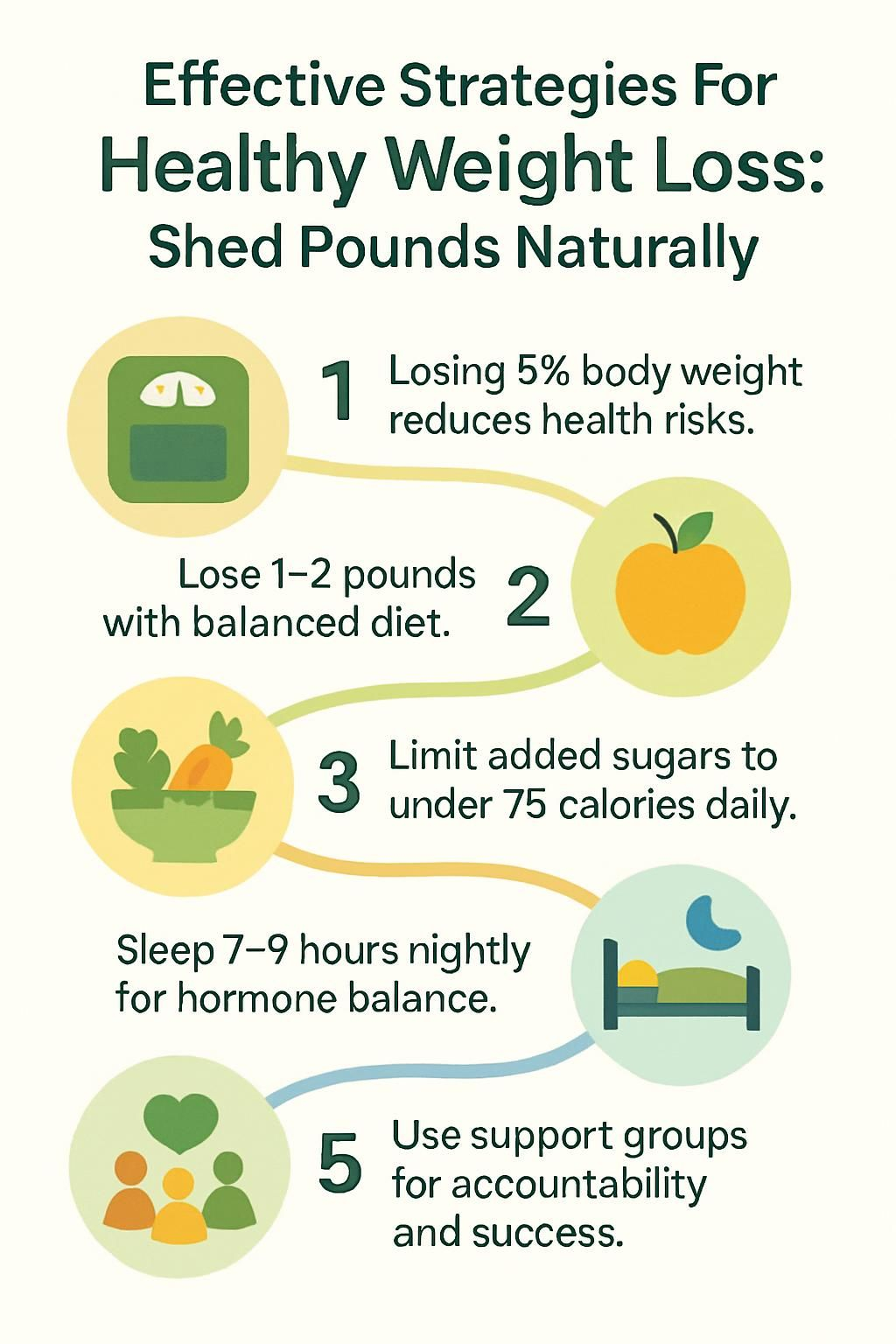Effective Strategies For Healthy Weight Loss: Shed Pounds Naturally
Our Nutrition Assistant AI Suite will transform your body. You will lose fat, get toned, and build muscle. Gain confidence and optimal health.
Trying to lose weight and keep it off can feel tiring. Healthy weight loss lowers your risk for heart disease and type 2 diabetes. This guide gives you clear steps for healthy eating, regular physical activity, goal setting, and daily habits that last. You will see practical weight loss tips without crash diets or risky shortcuts.
Start with small actions today so tomorrow feels easier.
Key Takeaways
- Losing 5 percent of your body weight can cut the risk of heart disease and type 2 diabetes, supported by the CDC and Mayo Clinic.
- Aim for 1 to 2 pounds per week, combine a produce-rich diet with at least 150 minutes of moderate aerobic exercise weekly.
- Limit ultra-processed foods and keep added sugars under 10 percent of daily calories, follow mindful eating and portion control.
- Get 7 to 9 hours of quality sleep; it helps balance ghrelin and leptin, the hormones that steer hunger and fullness.
- Accountability boosts success; a support group or workout partner helps you stay consistent. Talk with a medical professional first if you have chronic conditions.

Why is healthy weight loss important?

Before you set targets, it helps to know why healthy weight loss matters. Dropping just 5 percent of your weight can lower risk for heart disease and type 2 diabetes. If you weigh 200 pounds, losing 10 pounds can improve blood pressure, blood sugar, and energy.
Healthy weight management also reduces the chance of sleep apnea, high blood pressure, and prediabetes. Many clinicians suggest a steady pace, about 1 to 2 pounds per week, since rapid dieting often backfires. Slow changes build skills you can keep for life.
If you take medicine or live with other conditions, check in with your doctor first. A brief visit helps match your plan to your health needs.
How do I set effective weight loss goals?
Clear goals guide your eating and physical activity choices. Strong goals make daily decisions simpler.
How do I define my personal reasons for losing weight?
List the reasons you want to improve your health. You might want to lower the risk of diabetes, play with children without getting winded, or reduce blood pressure. Even a 5 percent drop can protect your heart and improve quality of life.
Write your reasons and post them where you will see them, like on the fridge. A journal or app can track progress and keep your focus on health instead of short-term setbacks. I once placed a sticky note above my sink, and it stopped many stress snacks.
Knowing why you want change helps you stay on track during hard days.
Ask for encouragement from people who support your goals. Avoid voices that shame or push extreme rules.
How can I set realistic and specific weight loss targets?
Use your reasons to set targets you can measure. Safe progress is 1 to 2 pounds per week, which matches CDC guidance. Start with 5 percent of your current weight. If you weigh 180 pounds, that first goal is about 9 pounds.
Pick two or three action goals, such as walking 30 minutes a day or adding vegetables to lunch and dinner. Track your steps and meals, then adjust if progress stalls. Skip extreme plans that promise 20 pounds in two weeks. They rarely last.
Celebrate small wins with non-food rewards. A new plant, a book, or a walk in nature keeps motivation high.
Dietary Strategies for Natural Weight Loss
Healthy foods help you lose weight and keep it off. Simple choices each day add up over time.
How can I prioritize whole, unprocessed foods in my diet?
Fill your kitchen with fruits, vegetables, beans, nuts, lean proteins, and whole grains. Choosing fresh or lightly processed items cuts added sugar and unhealthy fats.
The Mayo Clinic Healthy Weight Pyramid suggests making produce the base of most meals, with sweets kept rare. The Dietary Guidelines for Americans also favor plant-forward eating for weight and health.
Swap refined grains for brown rice, oats, or quinoa to raise dietary fiber, which helps you feel full. Practice mindful eating, notice flavors and textures, and pause between bites. This habit supports healthy living for adults and kids.
What is the best way to balance meals with protein, vegetables, and healthy carbs or fats?
Build each plate with three parts: lean protein, colorful vegetables, and healthy carbs or fats. Try grilled chicken with brown rice and steamed broccoli, finished with a teaspoon of olive oil.
Simple rules help:
- Eat at least four servings of vegetables and three servings of fruit most days.
- Choose whole grains over white bread or regular pasta.
- Use nuts and oils in small amounts for flavor without too many calories.
- Pick lean proteins that keep you full, like fish, poultry, tofu, or beans.
Skip pairing heavy creamy sauces with large servings of starch. That mix can spike blood sugar and drain energy later.
How do I limit sugary and processed foods effectively?
Make water and whole foods your default. Keep added sugar under 10 percent of daily calories. For many adults, that equals no more than 50 grams of added sugar on a 2,000 calorie plan.
Smart swaps work:
- Choose whole fruit instead of candy or soda.
- Pick olive oil or nuts in place of processed snack fats.
- Read labels for hidden sugars, such as corn syrup or dextrose.
- Plan meals in advance so convenience foods do not become your backup plan.
Eat slowly and check in with hunger before seconds. Small pauses curb cravings and help with long-term weight management.
What are mindful eating and portion control techniques?
Focus on your meal, and turn off screens so you can notice fullness. Eat at a relaxed pace and stop when you feel satisfied, not stuffed.
Simple tools keep portions in check:
- Use smaller plates or bowls.
- Serve food onto a dish, not from the package.
- Weigh calorie-dense foods like nuts to learn true portions.
A kitchen scale helped me enjoy nuts while staying within my calorie target. With practice, portion control feels normal and supports healthy digestion.
Physical Activity for Effective Weight Loss
Movement burns calories and supports weight management. Think of activity as a daily deposit in your health bank.
How much aerobic activity should I do weekly for weight loss?
Aim for at least 150 minutes of moderate aerobic activity each week. Brisk walking, cycling, or light jogging are solid choices. Break it into five 30 minute sessions to fit your schedule.
The American Heart Association and the CDC support these targets. Paired with healthy eating, this level of activity can support a loss of 1 to 2 pounds per week.
| Intensity | Target minutes per week |
|---|---|
| Moderate, like brisk walking | 150 minutes |
| Vigorous, like running | 75 minutes |
Start with daily walks, then add time or pace as fitness improves. If you have kidney disease or other chronic conditions, talk with your health care provider before you change your routine.
Why is strength training important twice a week?
Strength training at least two days per week protects muscle while you lose fat. More muscle helps you burn more calories at rest and keeps your metabolism steady during a calorie deficit.
Bodyweight moves and resistance exercises support joint health and lower injury risk. When I paired two strength sessions with regular walks, daily chores felt lighter and energy rose.
What small daily movements can help me lose weight?
Short bursts of movement add up fast. Take the stairs, park farther away, and stand or walk during calls. Schedule two or three mini walks during the workday.
Use active transport for short trips, such as walking or biking. Household tasks count too, including vacuuming, gardening, and mopping. Small shifts help you manage your weight while supporting heart health.
Behavioral Changes for Long-Term Success
Daily behaviors shape your results. Build routines you can keep on your busiest weeks.
How do I build sustainable habits instead of relying on quick-fix diets?
Set action goals that fit your life, such as 30 minutes of walking a day or vegetables at two meals. Aim for gradual loss, about 1 to 2 pounds per week.
Programs like the Mayo Clinic Diet teach long-lasting habits, not rigid rules. They center meals on fruits, vegetables, and whole foods, with treats kept small.
Skip fad diets that promise extreme results. Choose changes you enjoy and can repeat. Make movement fun so it sticks, like biking with a friend or joining a local class. Review and update your eating plan as your schedule shifts.
What strategies help manage stress and emotional eating?
Track what you eat, how you feel, and when cravings hit. Patterns often appear, such as stress snacks late at night. Many people improve once they see the trigger clearly.
Test new coping tools when stress rises. Try a walk, deep breathing, or texting a friend. Keep balanced snacks on hand, like fruit, vegetables, or a small handful of nuts. A dietitian can help if emotional eating feels hard to manage alone.
Mindful eating slows the pace so real hunger stands out from feelings. Listening to music and short relaxation breaks helped me avoid comfort eating during tough workweeks.
How can tracking progress keep me motivated?
Tracking gives you feedback you can use. Record foods and drinks, steps, workouts, sleep hours, and mood in a journal or app. Patterns will surface, such as skipped breakfasts on busy days.
Look for steady change, like 0.5 to 1 pound per week or fewer sugary snacks. Celebrate milestones with non-food rewards, such as fresh flowers or a walk in the park. I saw better progress once I posted simple notes on my fridge.
How do I ensure healthy food options are accessible at home?
Make the healthy choice the easy choice. Keep fruit on the counter and ready-to-eat vegetables at eye level in the fridge. Stock whole grains, beans, yogurt, and lean proteins.
Plan meals and snacks for the week so you are not trapped by last-minute hunger. Limit trigger foods in the house. Prepping salads on Sunday helped me stick to a plant-based pattern that was kind to my digestive tract.
How does sleep affect weight loss?
Good sleep strengthens your eating and exercise plans. It steadies appetite and stress responses so choices feel easier.
How much quality sleep should I get for weight loss?
Aim for 7 to 9 hours of sleep each night, a CDC guideline. A regular schedule supports metabolism, the process your body uses to turn food into energy.
Poor sleep can raise the risk of weight gain. Track bedtime and wake time to see how rest affects your appetite and activity. If sleep is hard, ask a health care provider for guidance.
How does sleep influence hunger hormones?
Too little sleep disrupts hunger hormones. Ghrelin, which increases appetite, can rise. Leptin, which signals fullness, can drop.
This shift pushes cravings for high calorie foods and makes portion control tougher. I noticed more late snacks after restless nights, so improving my sleep helped steady my choices.
Why is staying hydrated important for weight management?
Water supports metabolism and helps control hunger. Staying hydrated is one of the easiest ways to help you lose excess weight.
How much water should I drink daily?
Start with at least 8 cups, or 64 ounces, per day. Your needs change with activity, climate, and health conditions. If you exercise often or eat more fiber, increase your intake to support digestion.
Drinking water before meals can reduce calorie intake. Check urine color as a simple guide, light yellow usually means good hydration. I kept a bottle at my desk and noticed steadier energy and clearer skin.
What are good alternatives to sugary beverages?
Choose water first. Add slices of citrus, berries, or herbs for flavor without sugar. Unsweetened herbal tea and sparkling water are easy swaps for soda.
Most sports drinks and energy drinks add sugar you do not need unless workouts are very intense. For variety, try iced tea or plain black coffee. Read labels so hidden calories do not sneak in.
How can accountability and support improve weight loss?
Support keeps motivation high and helps you stay consistent. Progress feels easier when someone is in your corner.
How do I share my goals with friends or family?
Tell supportive people what you plan to do and why. Post your goals where others can see them, like the fridge. Invite a friend to plan meals or walk together.
Ask loved ones to cheer your wins and back you up during stressful weeks. Social support improves follow through in many studies. Consider a group or buddy for more structure.
What are the benefits of joining a support group or having a workout buddy?
Structured programs can raise your chance of hitting targets. Recent studies show people in programs are about 30 percent more likely to reach goals than those going solo.
A workout buddy can make exercise more enjoyable and cut dropouts by up to 50 percent. Support groups share recipes, tips, and ideas for getting unstuck. Some offer coaching from dietitians or trainers, which adds expert guidance without surgery as a first step.
When should I seek professional guidance from a dietitian or trainer?
If you have diabetes, heart disease, or another medical condition, see your provider before starting a weight-loss program. A referral to a registered dietitian or certified trainer can tailor a plan to your needs.
Dietitians design nutrition plans and coach behavior change. Trainers build safe, effective workouts for your fitness level. Expert help keeps progress steady and lowers the risk of injury or setbacks.
When should I seek medical help for weight loss?
Contact your doctor if weight does not budge despite consistent efforts, or if you notice new symptoms. Medical care can uncover hidden issues and keep your plan safe.
Why consult a doctor before starting a weight loss program?
Doctors can check for health problems that affect weight, such as thyroid disease or diabetes. They also review medicines that may increase appetite or slow metabolism. Basic blood tests give a clear starting point.
With this information, you can choose strategies that fit your health status. Ongoing monitoring helps you lose weight at a safe rate.
What health issues can affect weight loss?
Some conditions make weight loss harder. Diabetes and hormone issues can slow metabolism. Underactive thyroid reduces the rate you burn calories. Digestive disorders may limit what you can eat comfortably.
Some prescriptions for depression, high blood pressure, or seizures can raise appetite or cause fluid retention. Stress raises cortisol, a hormone that encourages belly fat. Age and genetics matter too.
Sleep apnea affects rest and is often linked with obesity. Losing weight can improve it for some people. A dietitian can adjust a plan to your diagnosis so progress is safer and more effective.
What are common misconceptions about weight loss?
Many claims sound appealing but are not backed by strong research. Knowing the facts helps you avoid wasted effort.
What myths exist around fad diets?
Fad diets promise fast loss without lasting change. Some cut whole food groups, like carbs or fats, and sell supplements with little evidence. These plans often ignore proven guidelines from groups like the Mayo Clinic.
Weight lost quickly tends to return. Research shows many people regain most of it within a few years after strict dieting. Balanced eating wins over extreme rules.
Why is rapid weight loss usually not sustainable?
Very fast loss often includes muscle, not just fat. Severe calorie cuts can slow your metabolism, which makes regain more likely later.
Quick fixes skip the habits that keep weight off, like planning meals and managing stress. The Mayo Clinic Diet encourages a steady 1 to 2 pounds per week after an initial start. I once tried a juice cleanse and regained the pounds within weeks because my old habits returned.
Rapid plans raise risks, such as nutrient gaps and gallstones. Slow, steady changes built on whole foods, activity, and support are safer and more durable.
What are the benefits of shedding pounds naturally?
Natural weight loss focuses on small steps you can repeat. The steady path is the one most people keep.
How does natural weight loss improve overall health and energy?
Losing 5 percent of your weight can lift energy and reduce fatigue. Balanced meals with produce, lean protein, and whole grains keep blood sugar steady, which helps you avoid crashes.
Regular activity strengthens your heart and lungs. Good hydration supports metabolism so your body uses fuel well. After I added daily walks and mindful meals, afternoon slumps faded and focus improved.
How does it reduce the risk of chronic diseases?
Even modest loss, such as 10 pounds for a 200 pound adult, can lower risk for heart disease and type 2 diabetes. You can improve blood pressure, cholesterol, and insulin sensitivity with steady habits.
Healthy weight also lowers risk for sleep apnea and some cancers. The Mayo Clinic Diet aligns with the Dietary Guidelines for Americans, which support lasting disease prevention through daily choices.
How does it enhance mental well-being?
Reaching goals builds confidence and improves mood. Regular activity can ease symptoms of anxiety and depression. Nutritious foods support brain function and stable energy.
Support from friends or a workout buddy adds connection and motivation. Mindful eating reduces stress around meals and builds a healthier relationship with food.
How do I maintain my weight loss long-term?
Maintenance is a skill. Keep practicing the habits that helped you lose the weight.
How do I create a long-term weight maintenance plan?
Track nutrition and physical activity even after you reach your goal weight. The Mayo Clinic Diet’s LIVE IT phase focuses on lifelong skills and planning ahead.
Weigh yourself weekly to spot small changes early. Adjust meals or activity when your routine shifts, such as a new job or travel. Set action goals, like 30 minutes of walking daily, alongside outcome goals to stay motivated.
Prepare for holidays and events with simple strategies. Bring a healthy dish, scan menus in advance, or schedule a morning walk. Check in with a buddy. Those chats helped me stay consistent during busy months.
Why continue healthy eating and regular exercise?
Smart eating and regular activity prevent regain and protect metabolic health. Balanced meals deliver steady energy and key nutrients. Activity supports mood, sleep, and muscle maintenance.
Keeping a kitchen full of healthy foods makes good choices easier. Adults who stay active also lower the risk of mobility loss with age, reported by the CDC. Daily walks increased my confidence along with my stamina.
Health information in this article is for education and is not a substitute for personalized medical advice. Talk with your health care provider about your specific needs.Selected sources: Centers for Disease Control and Prevention, American Heart Association, Dietary Guidelines for Americans 2020–2025, Mayo Clinic.
Conclusion
Effective strategies for healthy weight loss rely on habits you can repeat. Focus on whole foods, regular physical activity, steady sleep, enough water, and small behavior shifts. Set realistic goals, track progress, and seek support when you need it.
Create a simple plan and review it weekly. If you have medical concerns, check in with your doctor first. Natural weight loss improves your body and mind over time. Commit to these science-backed steps to shed pounds naturally and maintain a healthy weight for the long run.
FAQs
1. What are the most effective strategies for healthy weight loss?
Effective strategies include eating whole foods, tracking calorie intake, increasing physical activity, and setting realistic goals. Studies show that combining a balanced diet with regular exercise leads to better results than focusing on one approach alone (Harvard T.H. Chan School of Public Health).
2. How can I shed pounds naturally without using supplements or fad diets?
Focus on nutrient-rich meals like fruits, vegetables, lean proteins such as poultry or fish, and whole grains. Drink water instead of sugary drinks and avoid processed snacks high in added sugars or fats. Research from the Centers for Disease Control and Prevention supports gradual changes over quick fixes.
3. Is it important to track progress during weight loss?
Yes; monitoring your food choices and physical activity helps you stay accountable and spot patterns that affect your progress. A study published in Obesity found that people who kept daily records lost more weight than those who did not.
4. Can personal experience help motivate healthy habits?
Personal stories often inspire lasting change because they make success feel possible for others facing similar challenges. For example, after switching to home-cooked meals instead of fast food every day, I noticed steady improvement in my energy levels within two weeks.
Summary: Healthy weight loss relies on evidence-based methods such as balanced nutrition and consistent movement rather than extreme diets or unproven products; tracking habits increases accountability while real-life examples encourage persistence through setbacks.







